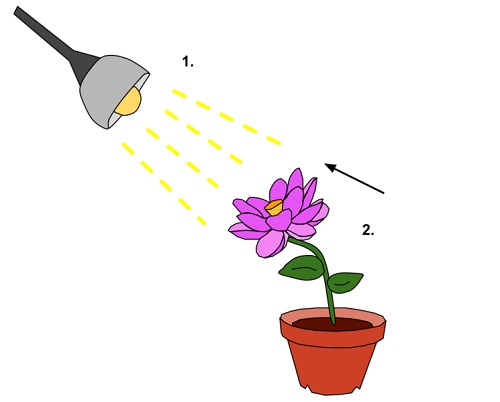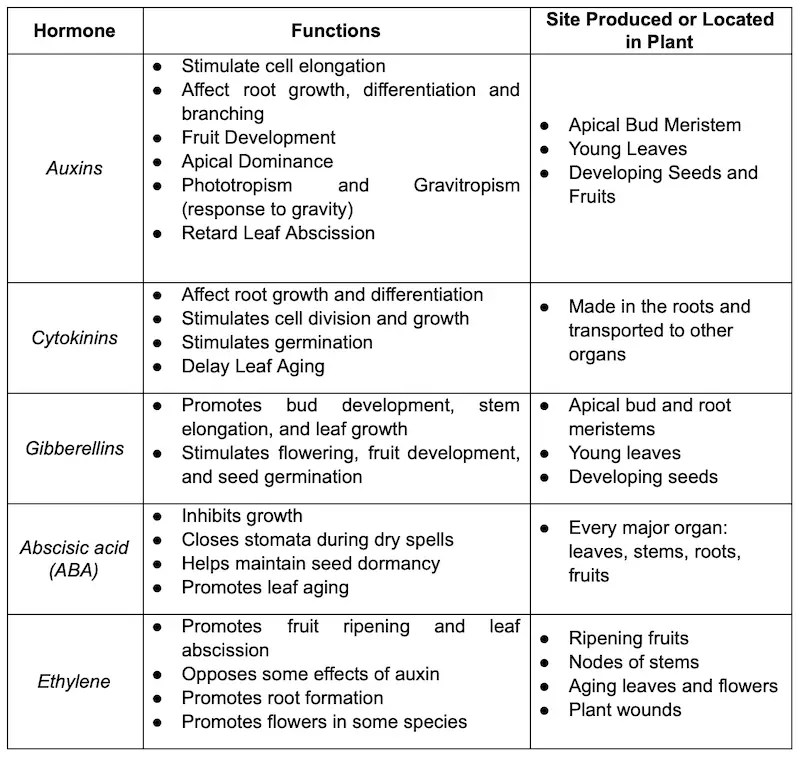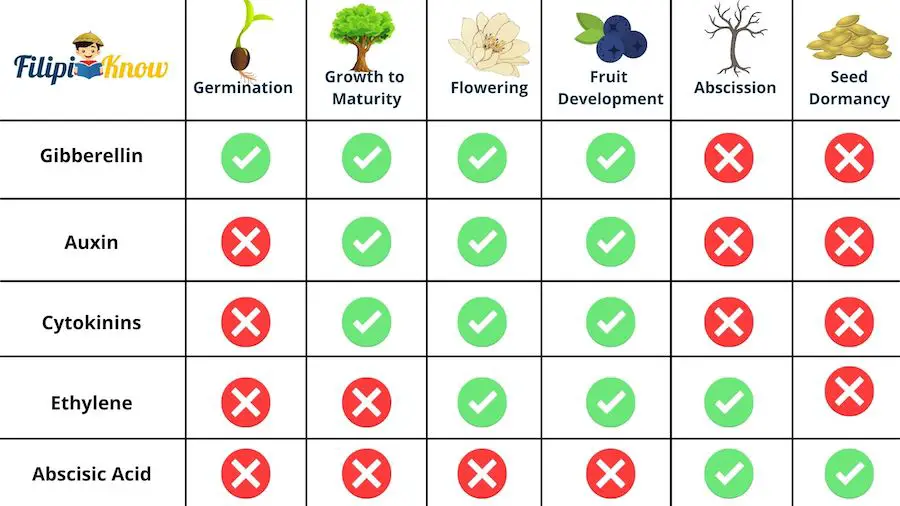Plant Hormones
Have you ever noticed that many houseplants grow to where there is sunlight? This phenomenon where any plant organs curve toward or away from any stimuli is called tropism. The observed response to light is called phototropism. So how are plants able to change the way they grow in response to their environment?

Much like animals, hormones control the body-wide responses in plants. A hormone, as a review, is a chemical signal produced in one part of the body and transported to where it is needed that changes the function of its target cells.
Major Plant Hormones and Their Effects on Plant Growth
Biologists initially identified five major types of plant hormones and they are summarized in the following table:

However, we now know that some of the hormones actually represent a group of related hormones and that there are important plant hormones beyond those listed in the table. An example would be brassinosteroids, which are steroid hormones that induce cell elongation and division in stems and seedlings. Their effects are so similar to auxin that it took years for plant physiologists to differentiate them.
As the table also indicated, each hormone can produce a variety of effects, depending on its site of action, concentration, and the plant’s developmental stage. In most situations, one kind of hormone does not act alone and instead, it is usually a balance of several hormones and their relative concentrations that controls the growth and development of a plant.
We will now take a closer look at the listed plant hormones and highlight key information about them.
1. Auxin
Auxin is any chemical substance that promotes seedling elongation, although it has multiple functions in flowering plants. The major natural auxin in plants is Indoleacetic acid (IAA).
The apical meristem at the tip of a shoot is a major site of auxin production. This hormone moves only in one direction, from the shoot tips toward the base, diffusing from cell to cell. This one-directional flow is interestingly independent of gravity, as experiments where plants were grown upside-down showed.
One hypothesis in how auxins make plant cells elongate is by weakening cell walls, which would allow it to be stretched since plant cell walls are usually rigid. Auxin promotes cell elongation in stems only within a specific concentration range. Above this range, auxin may inhibit elongation by inducing the production of ethylene.
2. Cytokinins
Cytokinins are hormones produced in actively growing plant tissues. In particular, the roots, plant embryo, and fruits. Its name is linked to promoting cytokinesis, or cell division and differentiation. They also slow down the aging of leaves and flowers by inhibiting the breakdown of protein. Cytokinins and auxins act together to control apical dominance.
One hypothesis proposes that auxins and cytokinins act antagonistically in regulating the growth of an axillary bud with auxins believing to inhibit the growth of axillary buds while cytokinins counter this action of auxins. Research is still ongoing as some believe that the effect of auxin is more indirect.
3. Gibberellins
Have you ever noticed how some rice seedlings in paddies grow so spindly that they topple over before they produce grain? In the 1920s, Japanese scientists discovered the cause to be from a fungus with the genus Gibberella.
The fungus produced a chemical that led to hyper-elongation of rice stems and scientists called the chemical gibberellin. However, researchers discovered the substance exists naturally in plants so rice plants infected with Gibberella had too much gibberellin as it would seem.
Young roots and leaves are major sites of gibberellin production. One of its main effects is to stimulate cell elongation and division in stems and leaves. In many plants, auxins and gibberellins must be present for fruits to develop. Gibberellins also promote seed germination in many plants.
In nature, gibberellins in seeds are probably the link between environmental cues and the metabolic processes that renew the growth of the embryo. In some plants, gibberellins seem to interact antagonistically with another hormone, abscisic acid.
4. Abscisic Acid (ABA)
Bud dormancy and abscission, the natural detachment of plant parts such as dead leaves and ripe fruits, in cotton plants were a subject of research in the 1960s where the compound abscisic acid (ABA) was isolated.
Ironically, ABA is no longer thought to be the primary hormone in either bud dormancy or leaf abscission but it is a plant hormone of great importance in other functions. In contrast to the three previously examined hormones, ABA slows growth with ABA often counteracting the actions of growth hormones.
Seed dormancy, an evolutionary adaptation that prevents seeds from germinating in unfavorable conditions, is influenced by the increased levels of ABA during seed maturation. ABA also influences the production of proteins that help seeds withstand extreme dehydration that accompanies maturation.
Gibberellins influence seed germination, so the ratio between it and ABA determines whether the seed will remain dormant or germinate. In addition, ABA is also the primary signal that enables plants to withstand drought. When plants begin to wilt, ABA increases in the leaves and rapidly closes the stomata thereby reducing further water loss.
5. Ethylene
During the 1800s, when street lights were lit using coal gas, it was observed that leaves of nearby trees drop prematurely. This phenomenon was determined to be the result of ethylene, one of the byproducts of coal combustion.
We now know that plants produce their own ethylene and this triggers a variety of aging responses in plants such as fruit ripening and programmed cell death. Ethylene is also produced in response to stress.
You might observe how unripe, fleshy fruits are generally tart, hard, and unappetizing–a feature meant to protect against herbivores. You might have also observed how one bad fruit could easily spoil the other in a bunch, say a banana. Ethylene is sometimes used to make fruits ripen faster and because ethylene is a gas, it can easily spread. Furthermore, when ethylene triggers fruit ripening, it also causes the fruit to produce more ethylene. The ripening process includes the breakdown of cell walls, which softens the fruit.
Deciduous trees in temperate regions tend to have their leaves fall during autumn. Like fruit ripening, the changes observed in these trees are an aging process. Leaves lose their green color due to the breakdown of chlorophyll, which would make the other pigments in leaves more visible–say the yellowish and orange pigments that make up fall colors.
When an autumn leaf falls, the base of its stalk is separated from the stem by a region called the abscission layer. The layer is a narrow band of parenchyma cells with thin walls that are further weakened when enzymes digest the cell walls, making it easier for the leaf to be dropped off. Before falling, cells next to the abscission layer form a leaf scar on the stem, and dead cells covering the scar will protect the plant from infectious organisms.
The following image summarizes the actions of the different plant hormones we tackled in this article:

We have tackled the major plant hormones and the functions they perform yet there are more plant hormones that have been discovered and are utilized in the plant industry. Up next, we will take on the different responses plants have with regard to environmental stimuli.
Next topic: Plant Responses to Stimuli
Previous topic: Plant Nutrients and the Soil
Return to the main article: Plant Form and Functions
Download Article in PDF Format
Test Yourself!
1. Practice Questions [PDF Download]
2. Answer Key [PDF Download]
Copyright Notice
All materials contained on this site are protected by the Republic of the Philippines copyright law and may not be reproduced, distributed, transmitted, displayed, published, or broadcast without the prior written permission of filipiknow.net or in the case of third party materials, the owner of that content. You may not alter or remove any trademark, copyright, or other notice from copies of the content. Be warned that we have already reported and helped terminate several websites and YouTube channels for blatantly stealing our content. If you wish to use filipiknow.net content for commercial purposes, such as for content syndication, etc., please contact us at legal(at)filipiknow(dot)net
